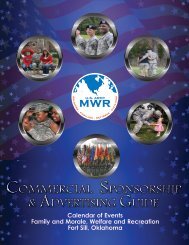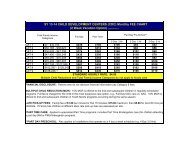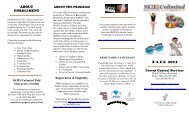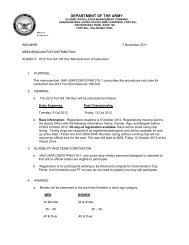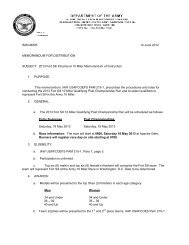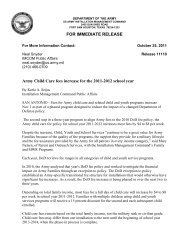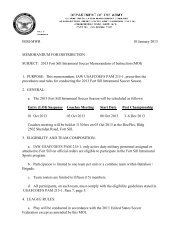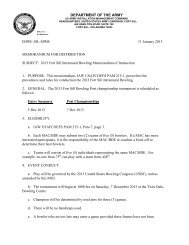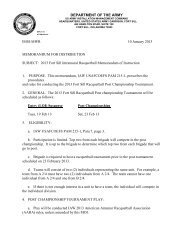Preparing and Managing Correspondence - Fort Sill MWR
Preparing and Managing Correspondence - Fort Sill MWR
Preparing and Managing Correspondence - Fort Sill MWR
Create successful ePaper yourself
Turn your PDF publications into a flip-book with our unique Google optimized e-Paper software.
. Appropriateness. Use a form letter to convey information about impersonal or routine matters.<br />
c. Flexibility. Form letters that are well designed provide flexibility <strong>and</strong> can be adapted to serve almost all the needs<br />
for which a form letter is economical <strong>and</strong> appropriate.<br />
d. Forms approval <strong>and</strong> control. See AR 25–30, The Army Publishing <strong>and</strong> Printing Program, for information on<br />
approval procedures <strong>and</strong> forms control.<br />
1–14. Exclusive For correspondence<br />
a. Use. Use Exclusive For correspondence for matters of a sensitive or privileged nature. Keep its use to a minimum<br />
to avoid delay of action if the named addressee is absent or unavailable to receive <strong>and</strong> act on the correspondence.<br />
Prepare Exclusive For correspondence in either the letter or memor<strong>and</strong>um format.<br />
b. Addressing. Address Exclusive For correspondence to the name <strong>and</strong> title of the addressee.<br />
c. H<strong>and</strong>ling. When preparing Exclusive For correspondence, place it in a sealed envelope. Type <strong>and</strong> underline the<br />
words Exclusive For on the envelope. Distribution center <strong>and</strong> mailroom workers will give this kind of mail to<br />
addressees unopened.<br />
d. Personal For. The term Personal For is not authorized for use on Army correspondence, but it is used in certain<br />
electronic message traffic as prescribed in AR 25–11, Record Communications <strong>and</strong> the Privacy Communications<br />
System.<br />
Section III<br />
Specific <strong>Correspondence</strong> Guidance<br />
1–15. Dissemination of comm<strong>and</strong> instructions<br />
The acronyms ALARACT (all Army activities) <strong>and</strong> ARSTAF (Army Staff) are used only in electronically transmitted<br />
messages. These acronyms assign responsibility for distribution instructions. Do not use them in Army correspondence.<br />
1–16. Abbreviations <strong>and</strong> brevity codes<br />
a. Memor<strong>and</strong>ums. Use abbreviations <strong>and</strong> brevity codes authorized in AR 310–50, Authorized Abbreviations <strong>and</strong><br />
Brevity Codes, for memor<strong>and</strong>ums. Use st<strong>and</strong>ard dictionaries for abbreviations not contained in AR 310–50. Prescribing<br />
regulations for various technical fields also provide authorized abbreviations, acronyms, <strong>and</strong> brevity codes. Abbreviated<br />
ranks are authorized for memor<strong>and</strong>ums <strong>and</strong> personal correspondence. General officers will use their full rank on all<br />
formal or official correspondence.<br />
b. Letters. Use only common abbreviations found in st<strong>and</strong>ard dictionaries. Do not use military abbreviations, brevity<br />
codes, acronyms, or military jargon in letters addressed to persons outside the Department of Defense. Military<br />
personnel will use their full rank (for example, Lieutenant General, Major General, Captain, Sergeant First Class, <strong>and</strong><br />
so forth) for letters.<br />
c. Abbreviation guidelines.<br />
(1) Established abbreviations are acceptable in all but the most formal writing. For reading ease, use only wellknown<br />
abbreviations or those you think would be known by the recipient.<br />
(2) When a word or title that is not well known will be used more than once in a document, place the abbreviated<br />
form in parentheses after the first time the word or title is used. Thereafter, only the abbreviated form is used. Do not<br />
place the abbreviated form of a word or title after the spelled out version of the word or title if the word or title will<br />
not be used more than once.<br />
(3) Do not place a period after abbreviated words in addresses, for example, St (street), Blvd (Boulevard), <strong>and</strong> so<br />
forth. The word <strong>Fort</strong> can be abbreviated (Ft) when used with a location.<br />
1–17. Acronyms<br />
Use military <strong>and</strong> civilian acronyms in memor<strong>and</strong>ums, if appropriate. Do not, however, use military acronyms when<br />
writing to individuals or organizations who would not be familiar with their use. When an acronym that is used more<br />
than once is not well known or is not contained in AR 310–50, spell out the word or title the first time it is used <strong>and</strong><br />
follow it with the abbreviated form. Thereafter, the acronym may be used. Above all, do not overuse acronyms.<br />
1–18. Letterhead<br />
a. Letterhead identifies the originating agency <strong>and</strong> provides the agency’s complete st<strong>and</strong>ardized mailing address.<br />
The letterhead does not show the organizational structure of the agency, nor should it do so. Therefore, do not make<br />
internal office designations part of the letterhead.<br />
b. Computer-generated letterhead will be used for all official correspondence <strong>and</strong> will conform to the following:<br />
(1) Use only the approved letterhead template provided by US Army Publishing Agency at www.usapa.army.mil.<br />
(2) No other seal, emblem, decorative device, distinguishing insignia, slogans, or mottos will be used unless<br />
approved by the Secretary of the Army.<br />
(3) All computer-generated letterhead will be printed on white paper.<br />
AR 25–50 • 3 June 2002<br />
3




